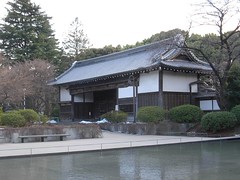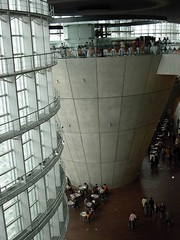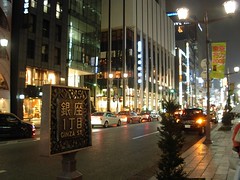I left China on the Chinese New Year’s Eve when a big part of the country was fighting the worst snow storm in 50 years. Tokyo should be several degrees warmer than Beijing, so I was relative at ease.
Snow started faling when I walked out of the airport. The girl who guided me to the driver was not pleased at all. “Yuki ga futte,” she complained. Funny that snow fell again, strong and blowing, the night I toured Ginza. Guess I brought a bit of China to Tokyo.
Beijing literally means “the capital at North.” It has been the capital of Chinese since the Yuan dynastry, for about 800 years now. In Chinese history, it is really a young capital. Xi’An, literally means “Peace on the West” was the 1st capital when China became China about 2200 years ago. Nanking, “capital at South,” was the capital of China before Beijing for a few hundred years too. Tokyo, now the capital of Japan, actually means “capital at East.” I guess this visit completes my collection of capitals.
If Tokyo is representative of Japan, then what a polite country it is. Most Chinese are still nursing the wounds Japanese inflicted on them during World War II. China fought 8 years against Japan during World War II — 4 more than most other countries. Japan brutalized Nanking in the most savaged and inhumane manner. To many Chinese, Japanese are cruel cold-blooded colonizers.
And those Chinese will be wrong. Human beings are really very similar in their basic nature. There are histories and cultures that shape social protocols. There are languages that separate communications. Once you cross those differences, you find decency and kindness underneath every races, countries, or tribes.
Unlike most places in China, there are no cell phone intrusions in Tokyo. During the entire 3 days, I heard not one single cell phone ring and never had the opportunity to overhear someone’s conversation. When they must talk in public, they covered their mouths and used low and hushed voices. On subways, most people wear a pair of earphones, read, or manipulate their cell phones in silience. One passenger next to me was watching live TV on his cell phones. Others appeared to be texting or emailing. Whatever they did, there was no sound. What a bliss coming from Beijing that is such an opposite.
Ueno Park (上野公園)

This is a big park at the center of a brisk neighborhood. Our destination was Tokyo National Museum that exhibits Courtly Millennium – Konoe Family (近衞家) Collection . I don’t know Japanese history well. This family seems to play important political roles for a few hundred years in Japan’s history. The collection include many historical documents regarding political appointments and ceremonial processions. There are lots of arts and artifacts that are more interesting to me.
The park itself is lovely and encompassed three museums, a shrine, a Buddhism temple, a large Buddha scrupture, and several restaurants. We had lunch in one of them. The service was thrift and thorough and the foods were delicious.
Roppongi (å…本木)

Roppongi has been the traditional embassy area of Tokyo. As such, it has always teemed with upscale and westernized entertainments. There is a direct subway path from my hotel, so getting to there is quite easy. We had a lovely dinner there and went again to visit the newly open Tokyo Midtown — a big city block of high-rise buildings that houses stores, restaurants, high-end hotels, galleries, and a museum. It is easily a full day’s activities in it. We shopped, ate, and visited Santory Museum of Art that was exhibiting Toulouse-Lautrec et la vie parisienne from Louvre.
Right next to Tokyo Midtown is the new National Art Center of Tokyo. This is a stunning architectural work that reminds me a lot of Beijing’s Capital Museum. The special exhibit of Yokoyama Taikan (横山大観), 50 Years on is quite enjoyable. This Japanese artist enjoyed a long and prolific life. His paintings were impressive and moving. I wanted to buy several replicas but ended up with some postcards, considering my luggage capacity.
Ginza (銀座)

This is the shopping haven of Tokyo Metropolitan just like Fifth Avenue of New York, WangFuJing of Beijing, and Union Square of San Francisco. It is always packed with tourists and shoppers. There are *two* Tiffany’s store here. The Harry Winston’s front door stood a large and intimidating guy to make sure no casual shoppers will ever walk in. There are so many restaurants of so many kinds of cuisines to satisfy the most discriminating foodies. Of course, several credit cards of high limits are a prerequisite to enjoy Ginza.
We were just strolling and experiencing it. The timely snow/rain cut the tour short and probably save us several hefty credit card bills.
Shijuku (新宿)
This is the governmental center of Tokyo, where city hall and muni-parliament are. Large department stores, shops, and restaurants surrounds the subway station. There are buildings devoted to electronic goods: gadges, TV, stereoes, computers, etc. There is this maze of underground structures to meet all your shopping and consumption needs without exposed to the elements outside.
Metro, Subways, and Trains

The subway system reaches every corner of this metropolitan. I can pretty much reach wherever with one transfer and about 20 minutes’ walk. That transfer, however, can be nearly half-a-mile’s navigation through a maze of esclators and pass-ways. There are big maps displayed everywhere in the subway station or street corners. That aids this city of walkers, and anyone who can read Kanji and basic Japanese. I feel safe and comfortable with a subway map and a simple tour guide in this city.
Restaurants
Every restaurants were good. Several are worth mentioning.
MatsuRokuKu (å¾¡æ›¹å¸ æ¾å…家) is a tiny one in Roppongi. The hallway is narrow to allow only a skinny person. There are 4 or 5 tatami rooms each house 4 to 5 people. Sake flew and bite size dishes came endlessly. Each one was so beautifully arranged and delicious too. The server will explain the dish in Japanese and our host will try to translate, with difficulties. The mistery enhanced the fun and sake clearly contributed too.
Hana MiChou 花・味兆(ã¯ãªãƒ»ã¿ã¡ã‚‡ã†ï¼‰ is a slightly larger one in Aoyama (é’å±±). There are 3 or so tatami rooms enough for 6 to 8 people. There is also a mess hall with western tables and chairs for about 20 seats. Again, the menu is largely pre-fixed, just the way we wanted. This time, our host chose Shocho, a stronger drink customarily diluted with ice water. We are now used to the parade of beautiful and small dishes. This one out-did MatsuRokuKu in style and elaboration. The climax was this hot-pot heated by miniture propane. The meal lasted until almost mid-night. Both foods and company were memorable.
Brasserie Paul Bocuse Le Musée is a high-end French restaurant inside of Roppongi’s National Art Center. People will wait for the meseum to open to reserve a table for lunch or dinner. We received a placard that told us to come back in an hour. At about 2pm, we got a table for two. The ambience was artsy, sophisticated, and comfy. The foods were pleasant and enjoyable. The service was friendly and warm. Nice foods for the soul and the body in one sitting, why didn’t other people think of this before?
Tokyo is an expensive city. Obstensibly, there is no sign of the decade of economic hard time. Swarms of people filled stores, museums, restaurants, and all those consumption places. The prices are at least on-par with US and sometimes quite a bit higher. (Subway fares across town cost about 6 to 8 dollars. StarBucks Grande Drip is $3.5. A sit-down quick-order “diner” style lunch for two is about $30. I saw a cateloupe at over $200! Yes, two hundred dollars.)
Japanese that I met are proper, polite, perseverant, disciplined, and detail attentive. These are wonderful quality for modern industrial successes and they proved that. There are many theories on this decade of tough time. Most attributed to the post-World War II keiretsu system, the aging population, and the life-time employment social contract. It seems clear to most economists that this society must change to fend off the surging China. Few of them agreed on how. The debate, or indecision, is wasting away the precious time.







Pingback: jp.Sun.com | sun